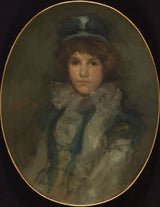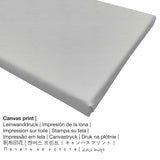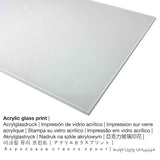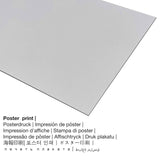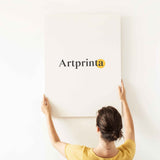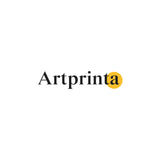James Abbott McNeill Whistler, 1898 - Blue and Coral: The Little Blue Bonnet - fine art print
Tax included. Shipping calculated at checkout.
Specification
In 1898 James Abbott McNeill Whistler painted this painting. The version of the artpiece was made with the exact dimensions: 32 1/2 × 27 1/4 × 3 1/4 in (82,55 × 69,22 × 8,26 cm). Oil on canvas was used by the American artist as the medium of the artwork. What is more, this artwork belongs to the art collection of Los Angeles County Museum of Art, which is the largest art museum in the western United States, with a collection of more than 142.000 objects that illuminate 6.000 years of artistic expression across the globe. The modern art public domain artpiece is included with courtesy of Los Angeles County Museum of Art (www.lacma.org).In addition to that, the work of art has the creditline: . What is more, the alignment of the digital reproduction is in portrait format and has a ratio of 3 : 4, which implies that the length is 25% shorter than the width.
Select your material
The product dropdown menu provides you with the opportunity to select the material and sizeaccording to your individual preferences. The following options are available for individualization:
- Poster print on canvas material: The Artprinta poster is a printed canvas paper with a granular surface structure. It is best suited for placing your art replica using a custom-made frame. Please keep in mind, that depending on the absolute size of the canvas poster print we add a white margin between 2-6cm around the print in order to facilitate the framing with your custom frame.
- Aluminium dibond: Aluminium Dibond prints are prints on metal with an outstanding depth. For our Direct Aluminium Dibond print, we print the artwork onto the surface of the white-primed aluminum composite. This direct print on Aluminum Dibond is one of the most popular entry-level products and is an extremely sophisticated way to display fine art prints, as it puts 100% of the viewer’s attention on the whole artwork.
- The canvas print: The canvas print is a printed cotton canvas stretched on a wood stretcher. Furthermore, a printed canvas generates a cosy and comfortable feeling. Canvas prints are relatively low in weight. This means, it is easy to hang your Canvas print without additional wall-mounts. Therefore, a canvas print is suitable for all types of walls.
- The acrylic glass print: An print on acrylic glass, often referenced as a an art print on plexiglass, will change the artwork into wonderful décor and offers a great alternative to dibond and canvas art prints. The artwork is made with the help of modern UV direct print machines. The great advantage of an acrylic glass print is that sharp contrasts and small artwork details become visible with the help of the very fine gradation of the print.
Disclaimer: We try everythig possible in order to describe the products as exact as possible and to illustrate them visually. Nevertheless, the tone of the print materials and the print result may differ slightly from the image on the screen. Depending on your settings of your screen and the quality of the surface, not all colors will be printed 100% realistically. Considering that all art prints are printed and processed manually, there might as well be minor discrepancies in the motif's exact position and the size.
Structured article details
| Print product type: | art print |
| Method of reproduction: | digital reproduction |
| Production method: | UV direct printing (digital print) |
| Provenance: | made in Germany |
| Type of stock: | on demand production |
| Product use: | wall décor, wall decoration |
| Orientation of the image: | portrait alignment |
| Image aspect ratio: | 3 : 4 length to width |
| Image ratio meaning: | the length is 25% shorter than the width |
| Product material choices: | canvas print, poster print (canvas paper), metal print (aluminium dibond), acrylic glass print (with real glass coating) |
| Canvas on stretcher frame (canvas print) variants: | 30x40cm - 12x16", 60x80cm - 24x31", 90x120cm - 35x47" |
| Acrylic glass print (with real glass coating): | 30x40cm - 12x16", 60x80cm - 24x31", 90x120cm - 35x47" |
| Poster print (canvas paper) sizes: | 30x40cm - 12x16", 60x80cm - 24x31", 90x120cm - 35x47" |
| Aluminium dibond print variants: | 30x40cm - 12x16", 60x80cm - 24x31", 90x120cm - 35x47" |
| Frame: | without frame |
Piece of art specs
| Title of the piece of art: | "Blue and Coral: The Little Blue Bonnet" |
| Categorization: | painting |
| Category: | modern art |
| Temporal classification: | 19th century |
| Created in: | 1898 |
| Artwork age: | more than 120 years |
| Medium of original artwork: | oil on canvas |
| Artwork original size: | 32 1/2 × 27 1/4 × 3 1/4 in (82,55 × 69,22 × 8,26 cm) |
| Exhibited in: | Los Angeles County Museum of Art |
| Museum location: | Los Angeles, California, United States of America |
| Website of the museum: | www.lacma.org |
| License: | public domain |
| Courtesy of: | Los Angeles County Museum of Art (www.lacma.org) |
About the artist
| Artist: | James Abbott McNeill Whistler |
| Gender: | male |
| Nationality: | American |
| Professions of the artist: | painter |
| Country of origin: | United States |
| Artist classification: | modern artist |
This text is protected by copyright © , Artprinta.com (Artprinta)
What does the website of the Los Angeles County Museum of Art state about the 19th century work of art created by James Abbott McNeill Whistler? (© Copyright - Los Angeles County Museum of Art - www.lacma.org)
Living an expatriate existence, James McNeil Whistler worked primarily in Europe, first in France, then in England. Yet, he was the single most influential American artist of the nineteenth century, not only in Europe, but also in the United States. His achievement lies at the heart of the late nineteenth-century Aesthetic movement, which prized the idea of "art for art's sake." His argument that art is neither didactic nor natural was a necessary prelude for the development of the radical modernist movements of the twentieth century, primarily abstraction. No American artist of any stature after the Civil War escaped his influence. Whether landscapes, seascapes, or figure studies, Whistler's paintings are marked by his attention to the visual effects of the surface, in particular, by great variations in glazing and texture. The subject matter is often secondary, a point that he calls attention to by titling the paintings with musical terms (Nocturnes) or abstract color phrases (most famously, the portrait of his mother is Arrangement in Grey and Black). The majority of his subjects are women, elements of an ongoing investigation of what constituted the concept of the "beautiful." While many were commissioned portraits, Whistler also used young working class women selected for the pictorial effect, in what the eighteenth century called "fancy pictures." Blue and Coral: The Little Blue Bonnet is a fancy picture from the end of Whistler's career and represents his mature style. It is the largest of his oval portraits and is one of his most finished works from this period. Whistler was an experimental artist even late in life. Many of his paintings were executed thinly, in glazes, as in The Little Bonnet. The costume is deliberately sketchy — the sitter's body and hat are depicted for their colors rather than for any accuracy of detail. Her face, on the other hand, is quite fully rendered and emerges out of the dark tones of the picture with great delicacy. This balance of the human interest of the subject and the purely abstract effects of tone and texture is the hallmark of Whistler's most successful portraits. Whistler is also represented in the museum by over 150 of his famous etchings and lithographs. View more works by Whistler in LACMA's collection.

